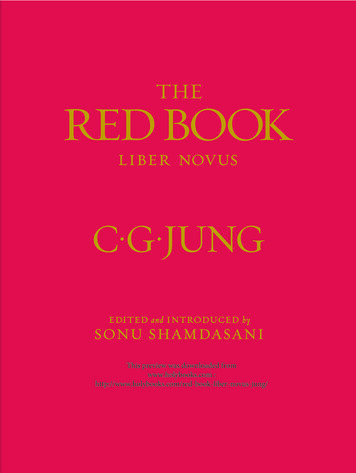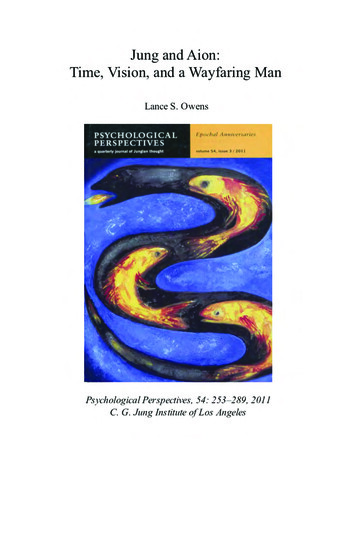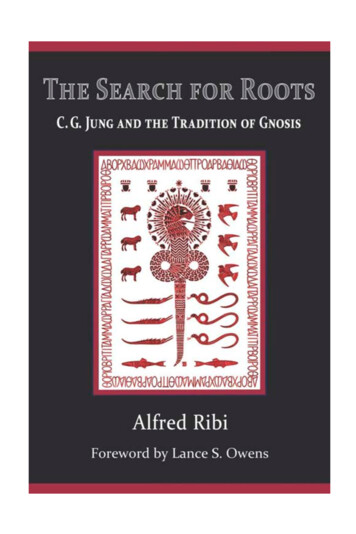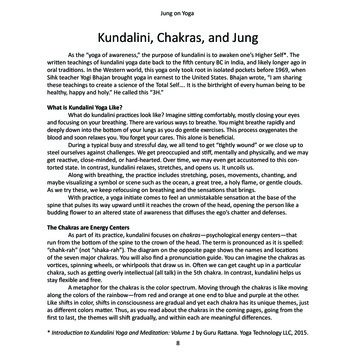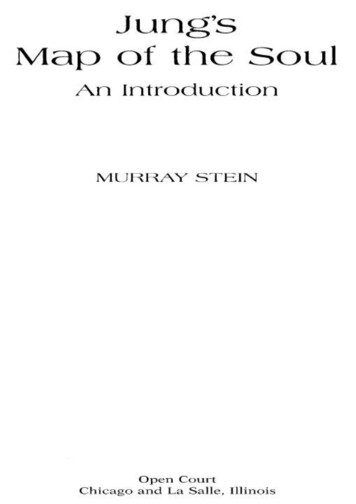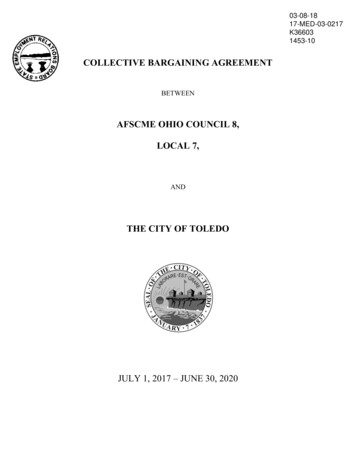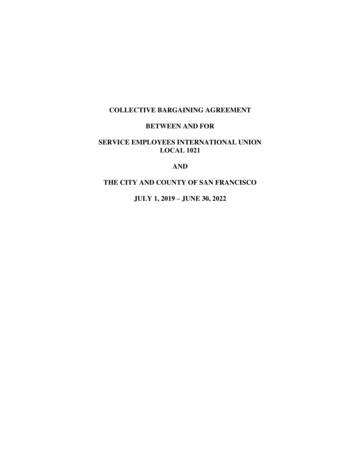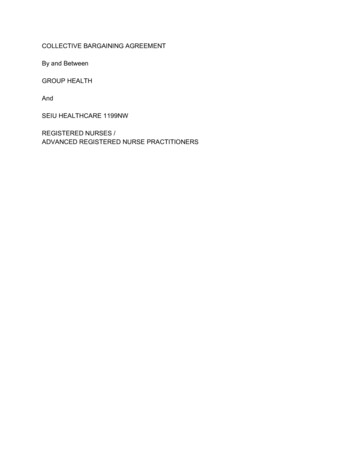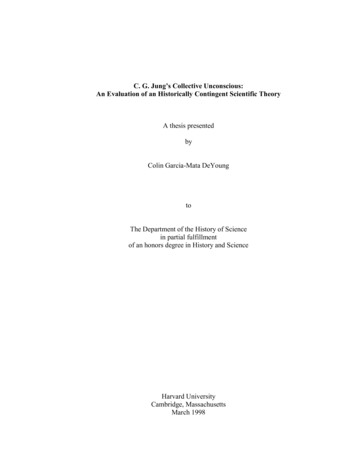
Transcription
C. G. Jung’s Collective Unconscious:An Evaluation of an Historically Contingent Scientific TheoryA thesis presentedbyColin Garcia-Mata DeYoungtoThe Department of the History of Sciencein partial fulfillmentof an honors degree in History and ScienceHarvard UniversityCambridge, MassachusettsMarch 1998
AbstractJung’s theory of the collective unconscious has never been studied extensively within thecontext of the history of science. Scholarship on the theory has generally come from twoopposing viewpoints, the Jungian and the Freudian. The former has generally treated thetheory ahistorically, attempting to demonstrate its current scientific validity, while thelatter has written it off as unscientific mysticism. When examined, however, through anhistorically-minded close reading of Jung’s writings and viewed in the larger context ofscience—especially evolutionary biology and heredity—from 1890-1930, the theoryemerges as consistent with the science of its day. Following this investigation, my finalchapter addresses the question of why the theory was marginalized in psychiatry andpsychology.Keywords:Jung, collective unconscious, psychoanalysis,Lamarckism, vitalism, organic memory
AcknowledgmentsFirst and foremost, I would like to thank Richard Noll for being my advisor onthis project. Not only was he an invaluable source of information, being a virtual walkingencyclopedia of nineteenth-century history of science and, more particularly, an expertJung scholar, he was also truly inspiring. From his class on Jung last Spring to mymeetings with him throughout this year, I have experienced a dawning realization of whatit really means to study and understand history—not as a set of disconnected anddisembodied texts, but as an organic whole. As I explored the life and thought of CarlJung, he trusted me to figure out what I was doing even when it meant wandering down adead end or two, waded through several drafts in a hurry as my deadline loomedominously near, and calmed me quickly in the rare moment of panic. On top of all that,he even fed me well, now and then. A million thanks for all your help, Richard.I would also like to thank everyone who has cultivated my interest in Jung: Myfather, who introduced me to Jung some years ago; Jordan Peterson, who through hisremarkable teaching inspired my historical interest in Jung as the source for many of hisideas, and who was always willing to discuss Jung over lunch; and Suzi Naiburg, whoguided me in my first expedition into Jung scholarship.Though in general they tried not to pester me, my parents and sisters provided mewith occasional moral support, which was greatly appreciated.And last, but far from least, I would like to thank Valentine Cadieux—for puttingup with me during several arduous weeks of writing when I wasn’t good for much else,for giving me support and encouragement, for helping out, and . . . well, for everything.Trying to list all the things for which I’d like to thank you would be moot . . .
Table of ContentsIntroduction: Evaluating an Historically Contingent Theory1Chapter 1. Historiographic Review1.1 The Nature of Jung Scholarship1.2 Scholarship on the Theory of the Collective Unconscious121415Chapter 2. The Collective Unconscious in Jung’s Writings2.1 The Importance of the Years 1916-191926272.2 The Development of Jung’s Terminology2.3 Making Sense of Jung’s Initial Presentation2.4 The Development of the Theory of the Collective Unconscious283039Chapter 3. The Collective Unconscious in Its Historical Context3.1 Problems in Jung’s Methodology3.1.1 The Question of Alternative Hypotheses3.1.2 Jung in the Context of Nineteenth-Century Wissenschaften3.2 Evolution and Heredity 1890-193049505460633.2.1 Lamarckism in the Theory of the Collective Unconscious3.2.2 Racialism3.2.3 Degeneration, the Primitive Mind, and the Biogenetic Law3.3 Organic Memory and Vitalism3.4 The Plausibility of Jung’s Theory6570768087Chapter 4. The Reception of the Collective Unconscious4.1 Jungian and Freudian Responses4.2 Other Responses4.3 A Puzzling Silence: Why was Jung Marginalized?Bibliography888993100103
Introduction: Evaluating an Historically Contingent TheoryAll scientific theories are historically contingent. They depend on the culture inwhich they are embedded for their particular meaning. That meaning is determined bythe scientific practice, knowledge, and belief, both explicit and implicit, of thesurrounding culture in that time and place. Non-scientific practices, knowledge, andbeliefs also go into the construction of a theory’s meaning. If one moves a theory to anew time or place, to another culture, one necessarily changes its meaning.All theories are contingent in this way, but the historically contingent nature of ascientific theory only becomes problematic when it is not recognized, especially if thetheory has been moved from one culture to another—and especially if the practices,knowledge, and beliefs of the original culture are incommensurable with those of thenew, that is, if the presuppositions on which those practices, knowledge, and beliefs arebased are not the same. If a theory’s presuppositions are made explicit, they can readilybe compared across cultures and hopefully understood along with the theories that rest onthem. Unfortunately, because of the very nature of Western scientific culture, many ofthe most important presuppositions of any scientific theory usually remain implicit. Oncean earlier theory has been accepted, it is often used without acknowledgment to support acurrent theory; in physics, to use a gross example, one does not need to cite Einstein whenreferring to a unified space-time continuum. In one sense, this is the great advantage ofscience—one is not always forced to begin at the beginning but may rely on acceptedtheory to formulate new theory. At the same time it can make understanding the rationalebehind a particular theory, especially one that is historically distant, quite difficultbecause science is not infallible. Our knowledge does not accumulate in a purely linearmanner. Theories change, their underlying presuppositions change, and the past oftenbecomes incommensurable with the present.Such is the problem underlying current treatment of C. G. Jung’s theory of thecollective unconscious, a theory developed in the early decades of this century but1
accepted today by some and criticized by others as if Jung had presented his argumentjust yesterday. Thoroughly contradictory evaluations of the theory are given by hissupporters and his critics, yet both groups seem able to support their arguments withpassages from his writings. What is going on here? Are Jung’s writings really thatinconsistent (as some critics have claimed)? I will argue that they are not; rather the faultlies in the ahistorical approach used to understand them. Jung’s theory has beendisplaced from its historical context and suffered significant loss of its original meaning,largely because of our failure to recognize Jung’s scientific presuppositions. In order toevaluate the theory of the collective unconscious fairly, we desperately need to replace itin its historical context.* * * * * * * * *Carl Gustav Jung (1875-1961) stands as a significant, though often neglected,figure in the history of psychology and psychiatry, especially notable for his role in therise of psychoanalysis in the twentieth century. Psychoanalysis may be summarilydescribed as a school of psychology dependent on the concept of a dynamic unconscious;born around the turn of the century, Sigmund Freud’s (1856-1939) psychoanalysis iswidely known as the prime example. Jung’s name, along with Alfred Adler’s (18701937), usually follows “Freud” in a triumvirate of the leaders of the main schools ofpsychoanalysis. Jung is often represented as a disciple of Freud who later broke with themaster to found his own school. He is in fact even more important to the rise ofpsychoanalysis than this would indicate, his support having largely made Freud’spsychoanalytic career at the outset.After studying science and medicine at Basel University in his native Switzerland,Jung surprised his peers and professors by choosing to go into psychiatry. In 1900, at theage of 25, he obtained a post at the well known Burghölzli mental institution, where he2
worked until 1909. The Burghölzli was headed by Eugen Bleuler (1857-1939), bestknown for coining the term “schizophrenia” in 1908. While many accounts date Jung’sinternational fame to his association with Freud, which began in 1905, he had by that timealready achieved some measure of international renown under Bleuler for his pioneeringwork with the word association test, which, though he did not invent, he refined andutilized extensively.1 In the word association test the subject is asked to respond to aword spoken by the experimenter with the first word that comes to his or her mind.These responses are noted and usually timed. A second step is often the repetition of thetask with the subject asked to recall his or her original responses. These tests were quitesuccessful and led to Jung’s development of his “complex theory,” which constitutes hisfirst original theoretical innovation.The theory of “feeling-toned complexes” was Jung’s first systematization of thecontents of the unconscious. Jung posited that similarly emotionally charged mentalcontents tended to form aggregates (become “constellated”) unbeknownst to theconscious mind. If strongly enough charged, these complexes could become“autonomous,” taking over control of a person’s behavior from his or her conscious mind,or “ego.” These unconscious patterns in the psyche,2 Jung found, could be uncoveredthrough the word association test by analyzing the subjects’ responses. Complexes mightbe identified in a thematic bias in the pattern of responses, or words relating to highlyemotionally-charged complexes might lead to longer than normal reaction times in theproduction of responses.3 Jung was internationally recognized for these discoveries.1Wilhelm Wundt(1832-1920), the so-called father of experimental psychology had employed the testpreviously.2The “psyche” being the entirety of the mind or soul.3For Jung’s original formulation of the complex theory see volumes 2 and 3 of The Collected Works of C.G. Jung, especially “The Psychology of Dementia Praecox,” in volume 3, and “On the Doctrine of theComplexes,” in volume 2, Appendix. (Henceforth The Collected Works of C. G. Jung (Princeton:Princeton University Press, 1957-1979), in their English translation, will be referred to in text as CollectedWorks and in citation as CW followed by volume and paragraph number. Where there is no paragraphnumber, page number will be indicated by “p.”.)3
It was Jung’s respected position in the wake of these accomplishments thatallowed him successfully to champion Freud, a relative outsider to the world of academicpsychology, whose radical views in The Interpretation of Dreams were not being wellreceived. The relationship (and its eventual break) that ensued between the two men hasbeen by far the most studied portion of Jung’s life, a state of affairs that has led many tooverestimate Freud’s influence on Jung’s ideas. Jung’s devotion to Freud was due less tothe supposedly revelatory effect of Freud’s ideas than to the charisma of their personalrelationship and Jung’s idealized evaluation of Freud as a speaker of previously hiddentruths, some of which Jung had been arriving at himself, influenced by many sources, andtherefore welcomed enthusiastically. Despite his enthusiasm, however, Jung differed onkey postulates of Freud’s theory even during his most intensely “Freudian” period. Thepoint to be made here is not that Freud’s influence on Jung’s life wasn’t enormous—itmost certainly was. What must be realized is that Freud’s influence on Jung’s ideas isnot so great as is usually portrayed. True, Freud greatly influenced Jung’s presentation ofthose ideas even after the latter’s break from the psychoanalytic movement inasmuch asJung continually took pains to distinguish himself from Freud in his writings. But Junghad many more, and more important, scientific sources for his ideas than Freud, and hiscontinuing attention to his former mentor was due largely to the dynamics of theirrespective positions in the academic, and even the cultural, world. It is those othersources, some of which have never been studied closely, in which I am particularlyinterested.The historical details that concern the present work begin shortly after Jung’srelationship with Freud had broken up rather inimically. Their prelude is a book ofJung’s, Wandlungen und Symbole der Libido,4 published in 1912, near the end of thefriendship of the two men. Though Jung and others have tended to identify this book as4Henceforthcited and referred to as Wandlungen. The English translation of this work to which I will referis not the significantly revised version found in CW 5, as Symbols of Transformation, but rather thetranslation of the original made in 1916, Psychology of the Unconscious: A Study of the Transformationsand Symbolisms of the Libido (Princeton: Princeton University Press, 1991).4
the major cause of the break because in it Jung proposed an alternative to Freud’scherished sexual libido theory, it would be more accurate to say that Jung’s voicing oftheoretical differences in this book was merely one indication of the difficulties betweenthe two men, rather than their cause. As John Kerr has elaborated upon with particularinsight and detail, the problems between Jung and Freud were complex, and developedover the seven-year course of their relationship.5 What is most of interest for mypurposes, regarding Wandlungen, is that it contains the first published references to thethemes of Jung’s thought, particularly his belief in a “racial” or “phylogenetic”unconscious, that would transform his complex theory of the psyche into his theory of thecollective unconscious, the theory that would become the hallmark of his unique schoolof psychoanalysis, analytical psychology.After his break with Freud, Jung withdrew from the academic world, resigning inApril of 1914 from his posts both as the President of the International PsychoanalyticAssociation and as privatdocent (lecturer) in the medical faculty at Zurich University.6By his own account,7 he went through a time of personal turmoil, lasting approximatelyfrom December of 1912 to 1918 and entailing mostly inner disturbances, though there isevidence that his relationship with his wife, Emma Jung, was troubled during this time(not surprisingly, given that it was then that Jung took his former patient, now assistant,Toni Wolff, as his mistress, a role she would occupy in his life for nearly forty years8).Jung was inundated by dreams and fantasies, and he emerged from this turbulent periodhaving had a number of visionary experiences that would dramatically affect his thinkingfor the rest of his life and with the beginnings of a systematic foundation for what would5JohnKerr, A Most Dangerous Method (New York: Alfred Knopf, 1993).(Ed.), The Freud/Jung Letters (Cambridge: Harvard University Press, 1988) 551.7C. G. Jung, Memories, Dreams, Reflections (New York: Vintage Books, 1989), henceforth cited as MDR.8Richard Noll, The Aryan Christ: The Secret Life of Carl Jung (New York: Random House, 1997) 94.6William McGuire5
become his vast theoretical edifice.9 That foundation, the core concept of Jung’spsychology, was the theory of the collective unconscious.The definition of the collective unconscious that follows is a provisional one,unavoidably somewhat simplified; a more comprehensive understanding of the theorywill emerge as my argument progresses:Jung posited the collective unconscious as a level of the psyche that was the sameacross all human beings. As such, it was not the product of an individual’s experiencesbut was inborn. He tended, when defining it, to contrast it with Freud’s theory of theunconscious, which, according to Jung, consisted solely of a “personal unconscious.” AsJung told it, Freud believed everything that lay in the unconscious psyche to be the resultof the individual’s life experience.10 Jung believed this level of the unconscious to be apart, but not the whole, of the unconscious psyche. His collective unconscious allowedfor certain contents to enter consciousness from within, without the individual’s havingpreviously been introduced to them in his external environment. Thus, his was a theoryof the psyche composed of three levels, conscious, personal unconscious, and collectiveunconscious, as opposed to Freud’s two.11 It will also be important to keep in mind fromthe outset that Jung’s theory was evolutionary and phylogenetic, in that he claimed thecollective unconscious to be inherited biologically and its contents to have been acquiredby the species over the course of its evolution. The collective unconscious can be definedas an innate level of the psyche embedded in the shared biology of humankind.Jung first explicitly introduced this theory in 1916, in an essay titled “TheStructure of the Unconscious,” widely recognized as his seminal work on the subject. Itis here that I begin my focused analysis. Between 1916 and 1919 the theory of the9Foran account of some of these visionary experiences see my discussion of the autobiographicalsignificance of Jung’s theory of the collective unconscious in Chapter 2.10Freud’s views on this subject are in actuality somewhat more complex. While Freud did indeedemphasize the nature of unconscious contents as repressed memories, he was also interested in inheritedaspects of the psyche, especially during and after his relationship with Jung. Jung emphasizes theirdifferences, for the obvious reason of his personal and theoretical antagonism with Freud at this point.11Freud had not yet developed his “id, ego, superego” model of the psyche.6
collective unconscious took on the form it would largely retain for the rest of Jung’s life.Hence, this is the most crucial historical period in which to pin down the meaning of thetheory. In these years, Jung published four essays on the topic, which I will examineclosely along with another manuscript, written in 1916 but only published more than 60years later in the Collected Works. These five pieces of writing contain the genesis anddevelopment of Jung’s theory of the collective unconscious.I focus more heavily on these few years and these few articles than on Jung’s laterwork because in order to approach the historical reality of Jung’s theory there is a realneed to go in depth into the texts themselves. Jung’s canon of writing is so large and sodiverse that it has been too easy for broad arguments to be made about his theories andsupported by quotes taken out of context from writings covering a span of fifty years andtwenty volumes. It is not that this method has led always to completely inaccurateanalyses of Jung’s theories, but it has obscured their development over the course ofJung’s life. (While the basic framework of the theory of the collective unconscious didsolidify in 1919, Jung’s views on certain secondary aspects of his theory did change overtime.) To juxtapose a quotation from Jung’s work in 1916 with another from twenty orthirty years later without noting the history in between leads to an inaccurate depiction ofJung as an intellectual figure outside the influence of time.Furthermore, and perhaps more importantly, this ahistorical approach has allowedfor the easy introduction of bias into interpretation, as evidenced by the fact thatdownright contradictory conclusions about Jung and his theories have been drawn andsupported by seemingly ample evidence. This interpretive dichotomy may be highlightedby noting that some have claimed Jung’s theory of the collective unconscious to be aperfectly viable scientific hypothesis (even today) while others have denounced (oroccasionally supported) it as a thoroughly unscientific, mystical or quasi-religious notion.I am convinced that the truth lies somewhere in between. A less biased picture of Jung’stheory would ideally take all of the subtleties of Jung’s Protean writings into account;7
while I can not attempt the completion of such a Herculean labor, I can shed light on alargely ignored aspect of Jung’s historical context that will help to make sense of thetheory of the collective unconscious.In order to understand Jung’s theory of the collective unconscious as he developedit in his published writings three questions must be addressed:1. What are the idiosyncrasies of his writing?2. What is his methodology?3. What are his sources?By answering these questions one will gain a clearer understanding of what Jung’s theorymeant to him and begin to get an idea of what it meant in the culture of his day.Anyone attempting to read Jung will immediately be forced to deal with the firstof these questions. Jung’s writing is frequently rather difficult, his style dense and, in hisown phrase, “circumambulating.” A further difficulty arises in that his language issometimes unfortunately imprecise. Furthermore, many of Jung’s theoretical writingsoften contain strong but unacknowledged autobiographical references, recognizable onlyto those intimately familiar with the details of his life, which can render the rationalebehind his approach puzzling at times. The theory of the collective unconscious,especially as Jung first presented it, is autobiographical enough in places that, in order todo it justice, one must elaborate somewhat on its place in Jung’s personal history. Theseconcerns have been addressed with some thoroughness by other scholars, but will need tobe reviewed briefly in relation to the specific texts and theoretical issues in question here.The question of Jung’s methodology has also been discussed at some lengthelsewhere, but it will be necessary to assess its relation to my topic specifically. Thelargest source of controversy has been Jung’s claim of empirical validity for his theory ofthe collective unconscious. Broadly speaking, it is undeniable that some of his work was8
empirical in the sense that a discipline like history is empirical, drawing conclusions fromlarge surveys of collected observations both current and historical. Jung also claimedobjectivity, however, for certain introspective observations and argued for the existenceof the collective unconscious as a biologically inherited entity, which would seem toplace it in the realm of biology, where one tends to expect a particularly rigorous sort ofempiricism. He frequently declared his methods to be scientific, yet often they do notseem to jibe with our understanding of scientific method. I will argue that thesediscrepancies stem from a combination of personal and cultural factors, and are notmerely indicative of a lack of rigor or of inflated claims on Jung’s part (which is not tosay that Jung’s methodology is entirely unproblematic, merely that there is more to thestory than has traditionally been recognized).The question of Jung’s sources is the one in which I am most interested, and alsothe one covering the most hitherto neglected territory. The existing scholarship in thisarea has been blind to certain key influences on Jung’s thought, largely, I surmise,because of the complexity introduced by the distinction between his explicit and hisimplicit sources. Jung’s explicit sources, those historical figures and contemporarieswhom he cites extensively or often, have naturally been recognized, and his connectionsto them have been studied. They will occasionally be worthy of note in my discussion,but they have already been explored fairly thoroughly. What has rarely been investigatedare Jung’s implicit sources, the ideas embedded in the culture of his time that were sofirmly ensconced and/or widely utilized that their origins were rarely noted. With Jungthese presuppositions become even more difficult for the modern reader to trace becausehe was on the cusp of a great shift in scientific approach.Jung grew up in the late nineteenth century, and, though all of his mature workwas done in the twentieth century, he remained strongly tied to the intellectual traditionsof the era of his birth. Many of these traditions were dying out in the first decades of thetwentieth century, others remained popular throughout these decades, though they are9
strangers to us now. Understanding the culture, and particularly the scientific culture, thatraised and educated C. G. Jung is the only way one will be able to understand thehistorically contingent meaning of his theory of the collective unconscious.Theories of Lamarckian evolution and heredity, racialism, organic memory, andvitalism combine to form the scientific axioms behind Jung’s theory of the collectiveunconscious. Of these, the Lamarckian mode of evolution—i.e. the inheritance ofacquired traits—is most important to Jung’s theory. Together with racialism, it alsoremained the most widely accepted of these theories during the first three decades of thiscentury. Vitalism was no longer widely influential in science but retained a few strongadherents to whom Jung sometimes referred. Theories of organic memory were on thewane in their more radical forms, but their influence remained important. Each of thesetraditions contributed key components of Jung’s thought and must be considered one ofhis sources, even when he does not discuss it explicitly. Interestingly, even where Jungoccasionally did refer to these issues explicitly, they have tended to remain unnoticed.The neglect of certain key influences by Jung scholars may, in some cases, be attributableto ignorance of their historical significance, and in others (i.e., Jungians), to the fact thatpeople often fail to see what they do not want to see. It is time that these importantcurrents of Jung’s thought were explored, so that both he and his theories may be betterunderstood as existing in a particular historical context.In some ways, I see this work as complementary to Richard Noll’s recentscholarship on Jung12; where he focused most heavily on Jung’s non-scientific culturalsources, both implicit and explicit, I am focusing on Jung’s scientific framework. In thisway I hope to offer an alternative perspective to Noll’s interpretation of Jung as beingmore interested in mysticism than science after 1913, and producing, in the collectiveunconscious, a theory that was a mystical metaphysics merely masquerading as a12RichardNoll, The Jung Cult: Origins of a Charismatic Movement (Princeton: Princeton UniversityPress, 1994) and Noll, The Aryan Christ (New York: Random House, 1997).10
scientific hypothesis. Noll argues that Jung’s identity as a “psychologist” was no morethan a mask and that “this twentieth-century mask was constructed deliberately, andsomewhat deceptively, by Jung to make his own magical, polytheist, pagan worldviewmore palatable to a secularized world conditioned to respect only those ideas that seem tohave a scientific air to them.”13 Though Noll does provide support for this interpretation,the story needs to be told from another angle as well. Through an investigation of Jung’soften implicit scientific sources, I hope to demonstrate that Jung’s theory of the collectiveunconscious was, if not entirely free from difficulty, still scientifically plausible in its dayand that Jung, therefore, may fruitfully be considered part of the scientific milieu. Itshould also become apparent, however, that Jung’s theory is no longer scientificallyplausible, at least as he framed it, contrary to the assertions of many of his currentsupporters. The fact that science has changed much since the 1920s has caused many tomisinterpret Jung’s theories either as scientifically plausible today or as whollyunscientific in Jung’s day.This argument will be better made after a review of the existing historicalscholarship on Jung, with particular regard for its treatment of the collective unconscious.This historiographic review comprises the chapter that follows. Having located thepresent study within a historiographic framework and having argued that it can usefullyfill a gap in the existing scholarship on Jung, I will proceed, in Chapter 2, to anexposition of the development of the theory of the collective unconscious in Jung’swritings. Chapter 3 will then focus on the significance of the theory in the largerhistorical context of the scientific culture of the late-nineteenth and early-twentiethcenturies. Following my argument that Jung’s theory was not scientifically implausibleby the standards of its day, the final chapter will examine its reception by the academiccommunity in the 1920s and 30s, which, if my hypothesis is correct, should prove not tobe entirely hostile.13Noll,The Aryan Christ xv.11
Chapter 1. Historiographic ReviewJung remains a somewhat difficult subject for historical study for several reasons.Much of the difficulty in Jung scholarship is due simply to the inaccessibility of manyprimary documents. A large number of these remain in the custody of Jung’s family,which, largely it would seem out of a desire to protect Jung’s image, and perhaps evenmore strongly his wife’s, has refused to make them accessible. Nonetheless, importantmaterial may be found in several historical archives, one of the most extensive of whichis the C. G. Jung Biographical Archive kept at the Countway Library of Medicine at theHarvard Medical School. This archive contains nearly two hundred in-depth interviewsmade in the 1970s with individuals who knew Jung personally and constitutes anexcellent source of primary material. Also useful are many of Jung’s selected letters,published in two volumes,1 and his complete correspondence with Freud has also beenpublished.2The Biographical Archive and the letters notwithstanding, one must contend withgaps in the primary biographical sources on Jung. The book Memories, Dreams,Reflections
Carl Gustav Jung (1875-1961) stands as a significant, though often neglected, figure in the history of psychology and psychiatry, especially notable for his rol
